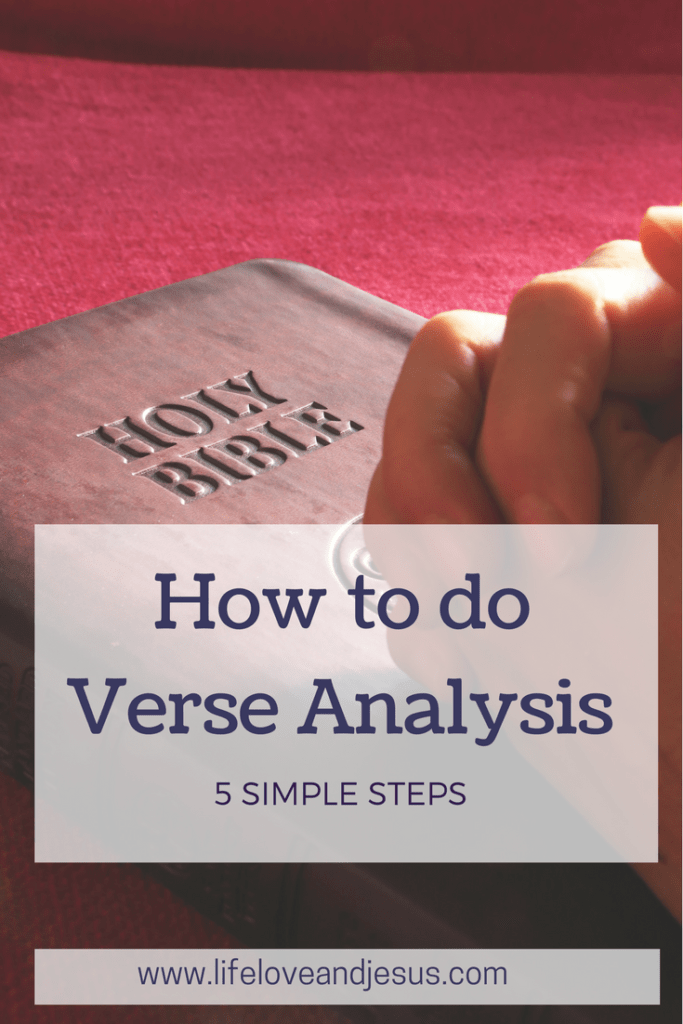How to Do Verse Analysis | 5 Simple Steps
This post contains affiliate links. If you click & make a purchase, I receive a commission! Thanks! Read my full disclosure policy. As an Amazon Associate, I earn from qualifying purchases.
Last time in our Digging Into the Word series, we covered the SOAP Method of Bible study. This is an easy way to get started with direct Bible study, as opposed to Bible study books. Today we will look at another simple method that focuses on only one verse. This method, the Verse Analysis method, is often used along with doing a book study. But that is not always the case.
Perhaps you have a favorite verse you want to study more, then you would use the Verse Analysis method. Perhaps you are memorizing a long passage, such as Psalm 37, and want to understand it more fully, then you would use Verse Analysis on selected verses in the text although probably not on all of them.

Verse analysis is also useful, as already mentioned, in doing book studies. If you are studying a book such as Philippians, then you would want to break it into sections, so it would be easier to study (we’ll get more into book studies next time). Let’s say the first section is Philippians 1:1-11. You might want to do Verse Analysis on just verses 9 – 11 so that you could understand the heart of Paul’s prayer and incorporate it into your prayer life. These are the three most common ways to use Verse Analysis.
Some Basic Reminders
Now that you know when to use Verse Analysis, let’s review some basics of study before getting into the method. First, begin with prayer. Second, write down what you learn (a printable for Verse Analysis is available with my Bible study resources). Third, be consistent and systematic – don’t just verse hop, but choose your verses based on some method. For example, if you memorize two verses every month, you might want to do Verse Analysis on those verses, twice a month, and do book studies the rest of the time. Finally, share what you learn with someone. Now, onto the method itself.
Verse Analysis Step-by-Step
Verse Analysis has five steps. The first step, after choosing your verse, is to write it down in your favorite translation. Some good choices are the New International Version (NIV), New American Standard Bible (NASB), New King James Version (NKJV), or the Holman Christian Study Bible (HCSB). There are others, but these are my favorites. If you are also memorizing the verse you are studying, you might want to write it down several times every day for a week. The second part of the first step is to come up with your own paraphrase of the verse. What is the verse saying? Put it into your language, but remember this is not the application, so stay away from “What is the verse saying to me?”

The second step is context. Read and re-read the verses just before and after your chosen verse to see what the context of the verse is. The handout I created for you has two questions in the context step: “What thoughts do the preceding verses add?” and “What thoughts do the following verses add?” Just as in step one, you are looking for what the verses are saying, not looking for applications.
The third step is questions and concerns. What questions do this verse and its context raise in your mind? What concerns do you have about understanding the verse and its context? Write these down as well. Since only a few verses are being looked at, there will probably not be any questions or concerns; write it down even if it’s only one. If you have no questions or concerns, write ‘none’ on the worksheet.[mailerlite_form form_id=11]
Fourth, you will want to find cross-references for your verse, look them up, and list them. These cross-references may lead to a future study or Verse Analysis. Your Bible may help here if you have cross-references listed in your margins or footnotes. The Thompson Chain Reference Bible would be especially helpful if you have one. Another place to look for cross-references is in reading the cross-references to the cross-references. For example, let’s say you look up the verse John 10: 11, and the cross-reference sends you to Psalm 23:1. Then, you look up the cross-references in Psalm 23:1, and it sends you to Isaiah 40:11 – so you add the Isaiah verse to your cross reference list. [Don’t know any of those verses? Go read them! They’re good].
Finally, step five, you get to the application. What is God speaking to your heart about this verse, that you can apply to your life right now? Not next week or next month, but now? Record what He wants you to do, and then do it.
Do a Verse Analysis!
A Verse Analysis could take you anywhere from 15 minutes to 30 minutes, depending how much in depth you go. Most of the time, it takes me 20 – 25 minutes to complete. Since this is a quick way to get more Bible study into your day and week, I highly encourage you to make time for Verse Analysis a few times every month. In fact, you could start today by making a list of favorite verses to study, and then choose one to do on the worksheet available for signing up for my emails. I have also done one as an example for you, which you can download here.[mailerlite_form form_id=11]







One Comment
Comments are closed.